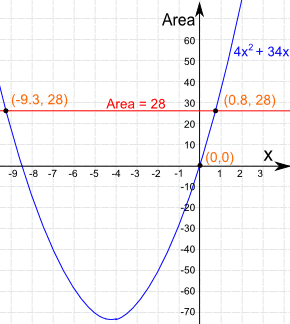Quadratic Formula
Key Questions
-
Since the quadratic formula is derived from the completing the square method, which always works. Note that factoring always works as well, but it is sometimes just very difficult to do it.
I hope that this was helpful.
-
Your company is going to make frames as part of a new product they are launching.
The frame will be cut out of a piece of steel, and to keep the weight down, the final area should be
# 28 cm^2# The inside of the frame has to be 11 cm by 6 cm
What should the width x of the metal be?
Area of steel before cutting:
Area =
#(11 + 2x) × (6 + 2x) cm^2#
Area =#66 + 22x + 12x + 4x^2#
Area =#4x^2 + 34x + 66#
Area of steel after cutting out the 11 × 6 middle:Area =
# + 34x + 66 - 66#
Area =#4x^2 + 34x# Let us solve this one graphically!
Here is the graph of 4x2 + 34x :

The desired area of 28 is shown as a horizontal line.The area equals 28 cm2 when:
x is about -9.3 or 0.8
The negative value of x make no sense, so the answer is:
x = 0.8 cm (approx.)
You can try it out yourself and find the roots of the quadratic equation using the quadratic formula
# x = [ -b ± sqrt(b^2 - 4ac) ] / (2a# There are many more examples at http://www.mathsisfun.com/algebra/quadratic-equation-real-world.html
-
Answer:
A few thoughts...
Explanation:
If you are wanting simpler versions of the quadratic formula, then here are a few thoughts...
Given a quadratic equation of the form:
#ax^2+bx+c = 0# the roots are given by the quadratic formula:
#x = (-b+-sqrt(b^2-4ac))/(2a)# Note that if
#b# is even, then the radicand#b^2-4ac# is a multiple of#4# , so we end up with a square root that can be simplified.We can incorporate this simplification into a simplified quadratic formula for the equation:
#ax^2+2dx+c = 0# namely:
#x = (-d+-sqrt(d^2-ac))/a# Further note that if (as is commonly the case)
#a=1# , then the roots of:#x^2+2dx+c=0# are:
#x = -d+-sqrt(d^2-c)# -
This is a little bit tricky but also incredibly elegant!
You start from your general quadratic:
#ax^2+bx+c=0#
Take#c# to the right side:
#ax^2+bx=-c#
The idea is now to transform the left side in something like#(a+b)^2# ;
Multiply by#a# ;
#a^2x^2+abx=-ac#
Multiply by#4# ;
#4a^2x^2+4abx=-4ac#
Add and subtract#b^2# to the left side:
#4a^2x^2+4abx+b^2-b^2=-4ac#
Take the#-b^2# to the right:
#4a^2x^2+4abx+b^2=b^2-4ac#
The left side can be written as:
#(2ax+b)^2=b^2-4ac#
And:
#2ax+b=+-sqrt(b^2-4ac)#
And finally:
#x=(-b+-sqrt(b^2-4ac))/(2a)#
Poetry in algebra! -
Suppose you have
#ax^2 + bx + c = 0# where a, b and c is any number. Plug these in the quadratic formula:#x= (-b+- sqrt(b^2-4ac))/(2a)# Plug the values and solve for#x# .
Questions
Quadratic Equations and Functions
-
Quadratic Functions and Their Graphs
-
Vertical Shifts of Quadratic Functions
-
Use Graphs to Solve Quadratic Equations
-
Use Square Roots to Solve Quadratic Equations
-
Completing the Square
-
Vertex Form of a Quadratic Equation
-
Quadratic Formula
-
Comparing Methods for Solving Quadratics
-
Solutions Using the Discriminant
-
Linear, Exponential, and Quadratic Models
-
Applications of Function Models